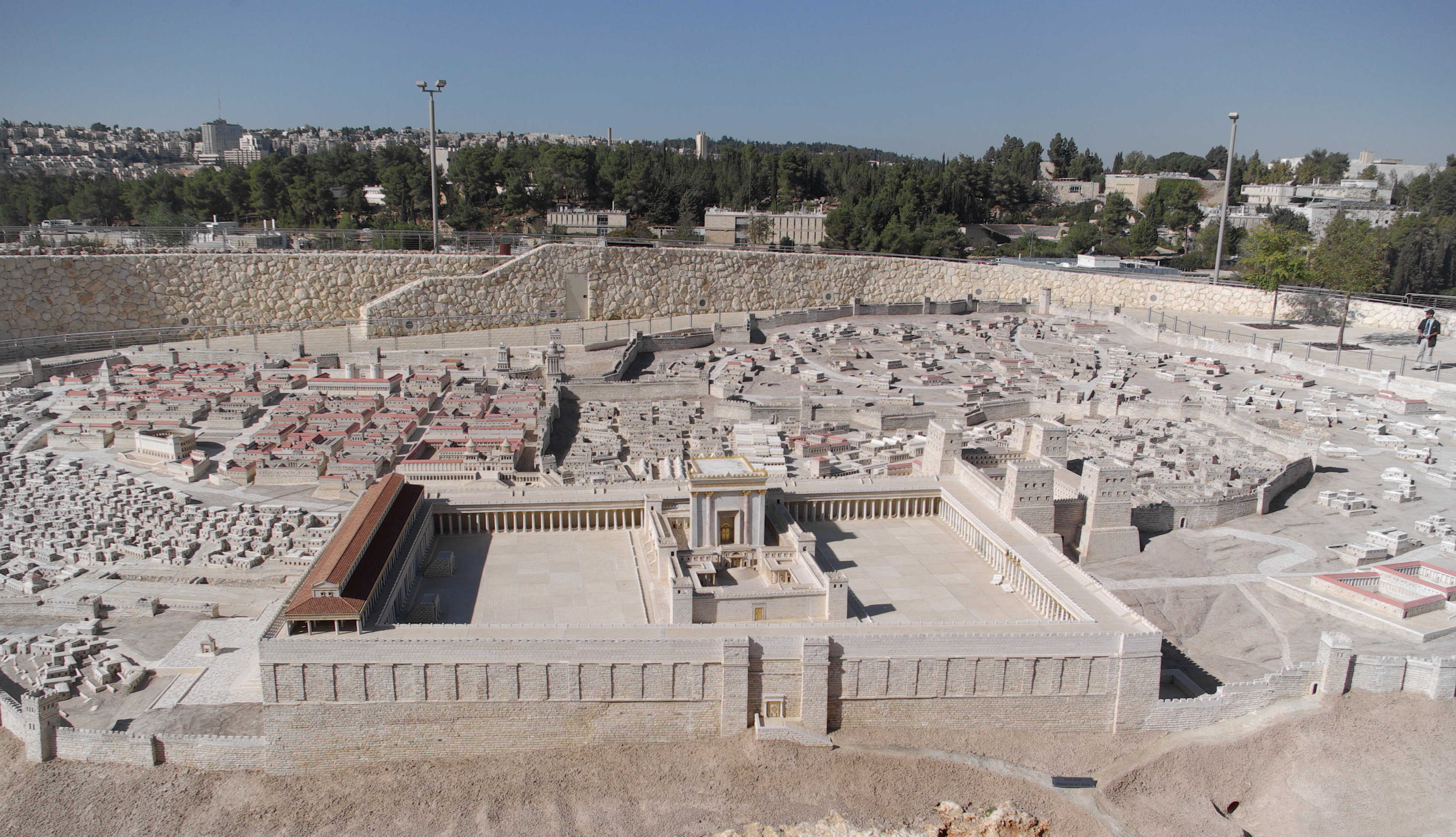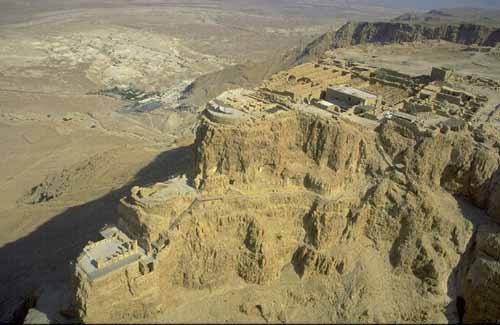Herod
(c. 72 BCE - 4 BCE?)
Rome had been growing and strengthening during the Hasmonean Period. In 161 BCE, near the beginning of the Hasmonean Period, Judah the Maccabee had made a treaty with Rome.
Corruption within the Hasmonean family speeded the fall of the Hasmonean Empire. Aristoboulos, a typical Hasmonean “loving son,” declared himself High Priest-King thirty minutes before the death of his mother the queen. His brother, John Hyrcanus, felt his brother hadn’t played fair. He revolted against him. By 67 BCE there was civil war in Judea, and the land was ripe for conquest. Rome took advantage of the situation. John Hyrcanus allied himself with Rome under General Pompey. Together, they succeeded in smashing most of Aristobulos‘ forces in 63 BCE. Hyrcanus and Pompey entered Jerusalem unopposed, but the Temple Mount, with its own fortifications, posed some problems. It took three months to take the Temple, and Rome gained control of Judea.

The Division of Herod’s Kingdom: Territory under Herod Archelaus (Blue), Territory under Herod Antipas (Purple)
Territory under Philip the Tetrarch (Brown), Jamnia under Salome I (Peach).
Click to enlarge
Confusion ensued. Rome was in a state of flux, with power struggles between Pompey and Julius Caesar; Caesar won. Julius Caesar appointed a governor to keep watch over the country, the son of an Idumean who had been forced to covert to Judaism, a man named Herod. After Caesar’s death, Cassius, Mark Antony, and Octavian all struggled for control of the Roman Empire. They all kept Herod in power.
The Hasmonean family wasn’t willing to give up, and, with the support of the Parthians (a nation in Asia Minor), there was a mini-revolt which was brutally suppressed.
After putting down the Judean/Parthian revolt against their rule, Rome appointed Herod king of Judea. Herod had complete authority, and he used it ruthlessly. He established an enormous secret police force, brutally killed anyone suspected of plotting against him, and created Roman peace by slaughtering all dissidents.
Herod controlled the sacrificial cult by placing a lackey in the position of High Priest. In any of his appointees was foolish enough to displease him, Herod killed him and replaced him with another lackey.
The vast majority of popular tourist sites in present-day Israel were originally built by Herod. Herod was security conscious. He built fortresses throughout the land just in case he should ever need sanctuary. These included Sabaste in the Hills of Ephraim, the central region of Israel; Herodium, just east of Bethlehem; and Jericho. Each of these fortresses was architecturally unique.
Sabaste was originally called Samaria. It had been the capital of Israel during the Divided Kingdom, and Samaria became the name for the entire northern region. Herod built over the ruins of Samaria, which had been built atop a mountain. He ordered the construction of an enormous colonnade of imported marble starting from the base of the mountain and rising to the summit.
The mountain Herod had chosen for the fortress Herodium was too low. Herod has his architects raise the summit and build his palace inside this man-made cone. It is generally believed that Herod was buried in Herodium, but no grave was ever found. Equally puzzling is the fact that archaeologists have been unable to discover a water source there.

Herodium
To supply water for the Jericho fortress, Herod had an enormous aqueduct built which carried water from Ein Kelt.
One of Herod’s greatest building projects was in Jerusalem. He wanted to enlarge and embellish the Temple, but the mountain on which Solomon had built the First Temple and on which Zachariah and Haggai had built the Second was just too small for his plans. That didn’t stop Herod. He dramatically increased the size of the Temple Mount by constructing huge encasement walls and filling them in with pure dirt, creating a large trapezoid. He was then able to proceed with his architectural plans to enlarge the Temple and its courtyards.

Model of the Second Temple
Herod protected the Temple Mount with a large military fortress called Antonia, honoring Mark Antony. He protected the western entrance of Jerusalem (and, incidentally, his villa situated there) with a huge tri-towered fortress called the Citadel. The Citadel loomed over the wealthy part of town, called the Upper City.
Herod’s most famous fortress was Masada. Located on the shores of the Dead Sea, Masada was built on a high plateau. Access was only along a steep, sharply winding path called the Snake Path. At the top, Herod had two palaces: a magnificent three-tiered northern palace complete with columns and frescoes offered a spectacular view of the Dead Sea. A larger mosaic- decorated western palace was probably planned as an administrative headquarters.

Masada
Herod’s architects created water channels and cisterns to provide drinking water during the long, dry summers. Huge storehouses guaranteed food in case of siege. A strong casemate wall enclosed the entire summit of the plateau. It was an awesome fortress and appeared to be invulnerable.
Herod’s projects were built through the use of thousands of Jews as forced laborers moving enormous blocks of limestone. Many of these blocks weighed more than ten tons. Because of his despotic actions, the Jews despised and feared Herod. Even projects that he commissioned to endear him to the people failed to change their hatred for him.
Herod continued to build. In honor of Octavian (Augustus Caesar), Herod took the ancient port city of Straton’s Tower just south of Haifa and renamed it Caesarea. There he created a deep sea port, surrounded the city with a wall, and constructed an amphitheater. To supply the port with ample water, Herod build another enormous aqueduct.
Although Herod was a terrible tyrant, his buildings and fortresses remain awesome architectural achievements even today.
Source: Gates to Jewish Heritage.
Photos: Temple Model - Berthold Werner, Public domain via Wikimedia Commons.
Herodium - Public domain via Wikimedia Commons.
Masada - Israeli Ministry of Tourism. All rights reserved to Itamar Greenberg and to the Ministry of Tourism.
Map: Rh0809, CC BY-SA 4.0 via Wikimedia Commons.


